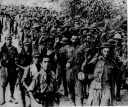The United States declared war on Japan, but it didn't make a whole lot of difference to Japan. In the minds of the Japanese leaders, they were already at war with the U.S. In the months that followed the attack on Pearl Harbor, Japan gained control of the Philippines, the Dutch East Indies (now Indonesia), much of New Guinea, the Solomon Islands, Guam, and other strategic areas all over the western Pacific. Japan even occupied part of the Aleutian islands, which belonged to Alaska.
Japan threatened to invade Australia as well. The U.S. response in the Pacific was muted somewhat because of President Franklin D. Roosevelt's decision to help Britain fight Germany above all. Much of the American manpower and machinery went to fighting the Axis troops in Europe. And because Japan had damaged much of the Pacific Fleet, an American response was slow in coming. But come it did.
Next page > American Victory > Page 1, 2 |
|
Social Studies for Kids
copyright 2002–2024
David White

 The
U.S. had had a presence in the Philippines ever since the
Spanish-American War, near the beginning of the 19th
Century. When Japanese took over the Philippines, they took
many Americans prisoner and forced them to march for miles
and miles to a prison camp. (This was the Bataan Death
March.)
The
U.S. had had a presence in the Philippines ever since the
Spanish-American War, near the beginning of the 19th
Century. When Japanese took over the Philippines, they took
many Americans prisoner and forced them to march for miles
and miles to a prison camp. (This was the Bataan Death
March.)

